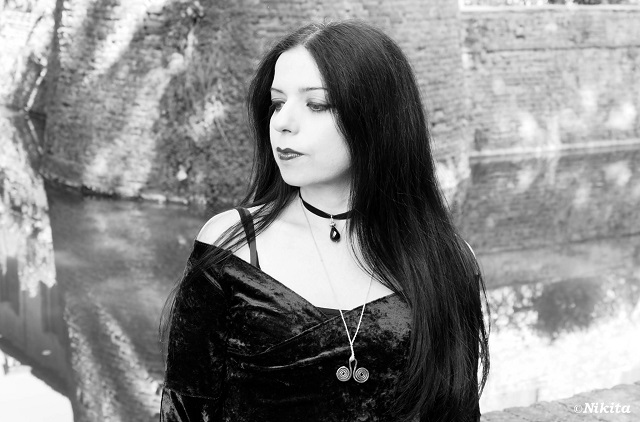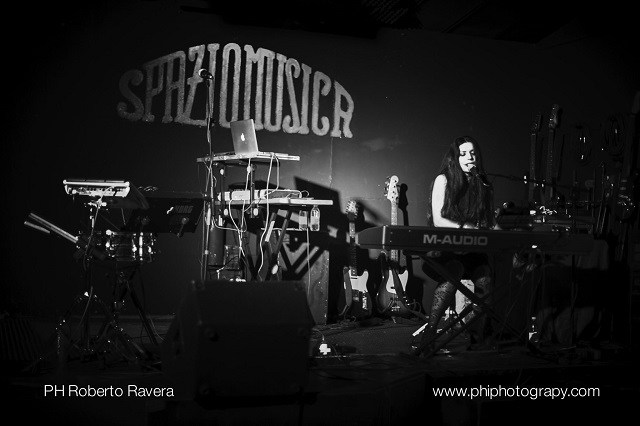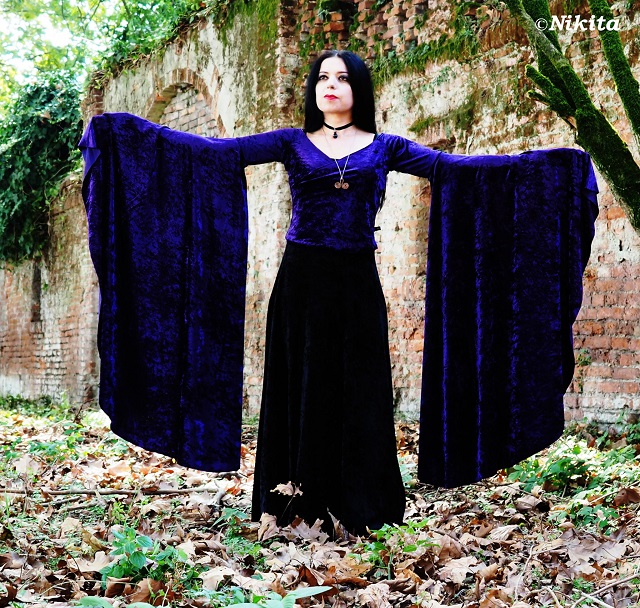The Armenian Weekly recently conducted the following interview with singer and musician Rita Tekeyan, who just released her new album “Green Line” the week of April 24. In the interview, the Lebanese Armenian artist, who now calls Italy home, speaks about growing up in Lebanon during the Civil War, the influence of studying architecture on her music, her Armenian heritage and the legacy of the Armenian Genocide.
Armenian Weekly (A.W.): The Lebanese civil war is part of your early childhood memory. Talk about how the war and its aftermath have impacted your life.
Rita Tekeyan (R.T.): War was part of everyday life. It was a normality. We didn’t know what it feels like not to be in war. I realized this and started to think about war just after I moved to Italy, when I had to experience war from a distance. This is what actually awakened inside of me that feeling of anger and rage, knowing that the people I love are in danger and the places I know are destroyed again. People who live war never want it; they want peace. Early childhood memories then came back, haunting me.
Read also
The infrastructure was destroyed—no electricity, no water, long queues to buy bread and other necessities, days and nights spent in underground bunkers that we used to call abri. War has happened always, since man has existed on earth. The methods have changed, but it has always been part of human existence, unfortunately.
War has definitely impacted my life. It takes a lot of courage for the parents who face life without fear for long years of war, to try to deal with all kinds of difficulties, finding solutions and never transmitting that sense of fear to their children, I wonder how they did that. My full respect to everyone struggling with war and staying sane. Experiencing war from a distance opened my eyes on how it was difficult to live in war and to accept it as part of everyday life. Knowing that every day your life is in danger, every day there are bombs falling and you never know if your house or your school will be there the next day. It’s like living with a question mark, no stability; it’s like a game where you can lose or win (remain alive), but the difference is that everything is real. The noise of the bombs and the sight of the bombs from the balcony are like fireworks, but they hit and kill and this is not a game.
A.W.: How did studying architecture in Beirut, a city carrying the scars of the civil war, help shape your thinking?
R.T.: Beirut is a very dynamic city and in continuous metamorphosis. Most of the time, people tried to hide the scars, to cover them, to pretend that everything is okay, but there were gaps and evident signs.
The most intriguing part was to analyze the sites, try to connect them to nature, to their surroundings, to the people living there, studying their needs and learning about the past. Walls usually whisper, creating that connection in space and time.
We had the chance to work on border sites between two countries in conflict, and that space in between was so silent. I also had the chance to analyze and work on a ghost town which people had abandoned, escaping from war, and there were these destroyed houses where life had stopped while we could still see traces of the past. Objects and various elements told us stories about the people who occupied that space.
While studying architecture, I researched a lot, connecting projects I worked on with topics I wanted to explore which helped me develop my ideas in a certain direction. It developed my sense of observation and attention to details, though never losing that vision of the whole. There were certain aspects of architecture which intrigued me most—the social and environmental aspects, protecting nature while designing and building, safeguarding trees and learning about the people living in the sites.
A.W.: Talk about your journey from architecture to music.
R.T.: Music has always been part of my life; architecture and music kind of coexist. My architecture thesis was titled “Architecture at the edge of Madness.” My idea was to provide alternative spaces to the so-called “mad,” as the thesis was based on the anti-psychiatry movement of Rudolf Laing, Michel Foucault’s “L’Histoire de la Folie” and that mental illness is a sociopolitical event which was created for specific reasons. The thesis also analyzed case studies of people considered “mad.” They were all artists, musicians, poets like Silvia Plath. Art and madness sometimes are correlated. Once we push the limits to the extremes and it goes out of the range of what is called “normal,” then we have the various tags and associations. In architecture, I also had the chance to analyze and study Igor Stravinsky’s The Rite of Spring and made a design project out of it. I even discovered the existence of annotations of dance movements. So art, architecture and music were all there.
What’s interesting about architecture is that it is very versatile and subjective. The architect has the power to make decisions. It is not like chemistry or mathematics or even engineering where there are formulas and you have a result, or you open a book and find the solution. Even in engineering, each project is a world itself, but there are few margins to invent or create. In architecture, no book will tell you what to do; you need to create it all from scratch after a site analysis. From the concept creation to execution drawings and building, this is the process.
I studied piano in the conservatory of Beirut and also took classical singing lessons. When I moved to Italy, I started singing in various rock and metal bands, playing live shows. I pursued a master’s degree in architecture and urban planning at the Politecnico di Milano. I’d say that both the journey of architecture and music are there together. There is some architecture in music as there is some music in architecture.
A.W.: What are your musical influences?
R.T.: My musical influences are a melting pot of different cultures from rock, metal, Nu metal, dark, experimental, industrial, traditional Armenian music, Middle Eastern music, 70s music and all the rebellion it contains. Many artists and bands were of great influence like Pink Floyd, Janis Joplin, Bob Dylan, The Doors, Led Zeppelin, Black Sabbath, Rolling Stones, Beatles, Frank Zappa, David Bowie, Einstürzende Neubauten, Bauhaus, The Cure, Joy Division, Siouxie, Velvet Underground, Nico, Nina Hagen, Demetrio Stratos, Diamanda Galàs, Dead Can Dance, Lisa Gerrard, Marilyn Manson, Rammstein, Metallica, Guns N’ Roses, Dream Theater, Simon & Garfunkel, Kate Bush, Muse. I also appreciate classical music—Igor Stravinsky, Philip Glass, Sayat Nova, Oum Kalthoum, Charles Aznavour. I also have great respect for System of a Down and Serj Tankian.
A.W.: You have said that your album is inspired by “Poetics of Space” by French philosopher Gaston Bachelard. Your songs also carry other influences: “Forêt Noire,” which you explain is “about places and spaces, how children are able to transform common objects into playgrounds,” carries references to Marcel Proust’s Madeleines. Talk about these influences.
R.T.: When the childhood house is not only a house, when the living space acquires other meanings and significance, it is not a mere space; it is “Poetics of Space,” when there is the “reverie” which takes you through a journey in the memory, where the space becomes infinity and the mind is traveling. The baggage of a traveler like in the song “BL Express” is a container of memories of objects which are associated with events, while in the song “Rooftops” there is a description of the rooftops’ space, which changes its function and meaning. It is not just a container; it becomes a “socializing space,” where events are taking place, people playing tavli, hanging their laundry, children playing hide and seek and creating tents. The space is decadent with electric wires, carbon dioxide smoke and chimneys, but yet it’s a childhood space of memories to hide from war. The space is idealized. The reality is distorted and within it the dreams.
“Forêt Noire” is that French delicious chocolate cake which is in this case the equivalent of Marcel Proust’s Madeleines. While tasting the cake, the involuntary memory is on, and the past is back, where there was this pastry shop like most other shops in Beirut—“no windows display the glasses have cracks, a small passageway is left to pass…” The lyrics say it all: concrete block walls and huge sand bag walls to protect their shops. These spaces became children’s hideaways, a place to imagine mountains to climb. The object changes its function and significance like Deleuze described.
Philosopher Jean-Jacques Rousseau and the relationship between nature and society have also been an influence. For example, in “Nora’s Tree,” this beautiful tree, taller than a four-story reinforced concrete building, “…after having survived more than 30 years of civil war and yet was cut down by the hands of men because of its massive presence in the neighborhood, in a land where they wanted to build …” also narrates how people adapt to war and how things have changed from the 80s to the 90s.
Some introspective songs in the album like “DK,” “Weight of Pain” and others are inspired by Charles Baudelaire’s Les Fleurs du Mal where the space is decadent and the time is ephemeral. Other inspirations include deconstructivism, surrealism and the Bauhaus movement.
A.W.: Your family has connections to Behesni. Your grandfather wrote about the Armenian massacres there. Please share your family’s experience during the Genocide.
R.T.: My grandfather Avedis Tekeyan was from Behesni and wrote the book “The Tragedy of Armenians of Behesni 1914-1918.” Each chapter is about a witness story, a real story, while the end of the book contains precious poems he wrote. He was not yet 18 years old. His father told him to leave as the enemy was reaching near, so he left home. As his poem “Yes Kou Aperet” describes, he left barefoot, running far away towards Aleppo. (I gave music and voice to this poem in my 2015 album “Manifesto Anti-War.”) My grandfather’s mother and little brother were deported with the caravans together with an aunt, while my great-grandfather, who was a bronze artisan, preferred to drink poison rather than be captured by the enemy. My grandfather Avedis was able to get reunited with his mother and little brother. In addition to being a writer and poet, he was also a photographer in Haifa, and then he moved to Lebanon.
My maternal grandfather Yervant Sinanian became an orphan after losing his parents and siblings. He was raised in an orphanage in Cyprus. Then he moved to Aleppo, until he settled in Beirut with his family. My maternal grandmother Mayranoush was not yet born during the Genocide, but her mother—my great-grandmother Santoukht—lost her parents and siblings; she was teenager at the time. Unfortunately, I don’t know if I will ever be able to build my family genealogical tree.
A.W.: The Armenian Genocide and the Lebanese civil war are themes tackled in your most recent album titled “Green Line.” Talk about this project.
R.T.: “Green Line” actually continues what I started with my EP “Manifesto Anti-War” released in 2015 for Rosa Selvaggia Italian independent label. The song “Green Line” itself was included in my EP. Most of the songs on my new album were written more than 10 years ago, contemporary to the previous songs but never officially released until now.
It all started when I decided to make notes of my childhood experience of war. The music is minimal, bearing in mind the concept “less is more.” I wanted to reach and focus on the essence of these memories—kind of obsessive and tribal—with repetitive words. Subconsciously the information was there, but there was complete chaos. This involuntary memory brought back a lot of events in my mind. There were fragments and discontinuity. I had to give a new order through words and music. Inspired by the deconstructivism movement in architecture, I realized that this was my way to preserve my childhood memories in a newly constructed fairytale. At the start, I just wanted to express my feelings of rage and anger towards a war that no one wants, this sense of incapacity to change things and to watch from a distance.
We also grew up with grandparents’ stories about the Armenian Genocide, which was also part of our everyday life. There was too much violence, too many images related to the evil of mankind. My grandfather’s book was a huge inspiration for me and guided me. The song “Y,” which is inspired from scenes from this book, asks “why (Y) all this cruelty?” Unfortunately, it’s still a relevant question and applicable to the current situations in which we are living.
A.W.: You have been calling Italy home for almost two decades now. The country has been hit hard by the pandemic. How has the pandemic impacted performing artists in general and your work in particular?
R.T.: Italy has inspired me through its beautiful nature, its people and historic and ancient castles. It is where I was guided and had the time to meditate and observe. The pandemic did hit hard; it is all about adaptation, finding solutions to survive and getting rid of what is not essential. Staying home in lockdown is not the same as staying underground in bunkers for months because there are bombs upstairs. But still, it has been a big challenge for everyone to cope with this new “normality.” We don’t even know if things will ever get back like before. There are big changes happening in the world, but the world is going mad.
The pandemic has definitely impacted performing artists. It’s been more than a year since I’ve had a live show. In March 2020, I had to go to Sicily for a couple of weeks to record the vocals and piano of my album “Green Line” where the producing label Seahorse Recordings is based, but since there was the lockdown, I had to figure out another solution. I recorded in a studio next to my home on Garda Lake. I feel privileged to live in a place surrounded by nature. I take long walks on the lakeside; that was enough for me to regenerate and breathe fresh air.
Music is my passion, not my profession. So I kept working from home. But a lot of my musician friends, fellow artists and actors who live off their art are in a severe economic crisis.
A.W.: What is next for you?
R.T.: I am dedicating my time to promoting my latest album. My aim is hopefully to bring my music live on stage in the near future. I would also love to prepare more music videos. There are music videos for two singles “Devil’s OB” and “Y” by talented Italian video producer Enrico Fappani, who was able to transform my ideas and music into brilliant artwork.
I have been invited to collaborate with Italian violinist and musician Michele Gazich on some tracks of his new album. We had already collaborated on his 2018 album on the song Maltamé. I also had the honor to collaborate with Italian neo-psychedelic band No Strange on the rearranged version of Kilikia.
Other musician friends have invited me to participate in their projects. Most of them are really interesting, so I will have the chance to explore new sounds.
I also have plans to translate my grandfather’s book into Italian and English, and probably in other languages I speak, but for now I am taking my time with that.
Main Photo Caption: Rita Tekeyan (Photo: Nikita Rosa Selvaggia)





























































